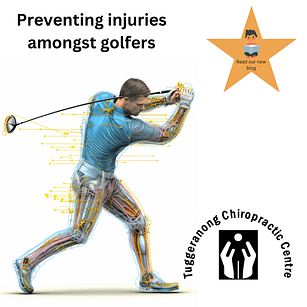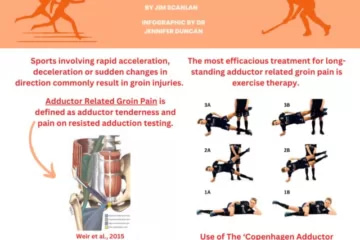By Dr. Nash Anderson B.Sc. M.Chiro; ICCSP. Chiropractor.

As golf swings into action around the world, we at our Tuggeranong Chiropractic Centre are as excited as you are. However, we also understand there are physical and psychological demands that golf places on players. In light of recent injuries in the golf world, we want to share some insights on managing and reducing the risk of injuries in elite golf, based on a recent article published in the British Journal of Sports Medicine1.
The Iceberg of Golfing Load
Golf is a sport that requires a combination of physical exertion and fine motor skills. While the physical intensity of golf may not be as high as other sports, the psycho-sociological demands often go underestimated1. The lifestyle of a golf tour professional is distinct from many other athletes, with factors such as sleep duration and quality, air travel, transit time, and time zone changes all playing a role in a golfer’s performance and injury risk1.
The Importance of Load Monitoring
The big phrase “Load management” (as discussed in our other recent blog) has become a popular topic of discussion amongst coaches, practitioners, and athletes alike. It often focuses on physical load in the form of external (work undertaken by the athlete) and internal (psychophysiological response of the athlete) load1. Although we can assume that these rule apply as they do in other sports there is limited research examining load monitoring in golf1.
The Role of Sleep and Stress
Sleep is essential for health, wellbeing, and optimal athletic performance. Disrupted sleep can have a harmful impact on physiological and cognitive function1. Additionally, the psychological strain from the need to keep their tour status, earn a living, and pay expenses can lead to significant stress, which has been shown to negatively affect both short-term and sustained performance in athletes1.
Conclusion
Despite the proliferation of load monitoring in professional sports, there is little evidence to demonstrate how and if load monitoring is occurring in golf and to what extent it impacts on performance and injury risk1. A greater understanding of how monitoring tools (of both physical and psychological load) are currently being used would be advantageous, to ensure that future tools are ecologically valid and suitable for a golfing context1.
Although some of these principles in this article are related to the elite, many of the principles still apply to golfers of all levels. Managing the psychological aspect can be beneficial to your performance and injury prevention. At our clinic, we are committed to helping golfers understand and manage these factors to reduce the risk of injuries and enhance performance. Stay safe, and if there’s anything we can help with, get in touch on 02 6292 1092 or book online.
For more info we recommend reading the original BJSM blog: https://blogs.bmj.com/bjsm/2020/09/25/beyond-physical-load-in-golf-the-tip-of-the-load-iceberg/
References
- West SW, Fern J, Canter L, Murray A. Beyond physical load in golf – the tip of the load iceberg. BJSM blog – social media’s leading SEM voice. [Internet]. 2020 Sep 25 [cited 2023 Jul 27]. Available from: https://blogs.bmj.com/bjsm/2020/09/25/beyond-physical-load-in-golf-the-tip-of-the-load-iceberg/ ↩ ↩2 ↩3 ↩4 ↩5 ↩6 ↩7 ↩8 ↩9
- Halson SL. Monitoring training load to understand fatigue in athletes. Sports Medicine 2014; 44 (2): 139-147. doi:10.1007/s40279-014-0253-z
- Impellizzeri FM, Marcora SM, Coutts AJ. Internal and External Training Load: 15 Years On. International Journal of Sports Physiology and Performance 2019. doi:10.1123/ijspp.2018-0935
- Williams SB, Gastin PB, Saw AW et al. Development of a golf-specific load monitoring tool: Content validity and feasibility. European Journal of Sport Science 2018; 18: 458-472
- Heath E. PGA Tour Players to Wear Whool Bands To Stop Covid-19 Spread. In, Golf Monthly. Online; 2020
- Luscombe J, Murray AD, Jenkins E et al. A rapid review to identify physical activity accrued while playing golf. BMJ Open 2017; 7. doi:10.1136/bmjopen-2017-018993
- Murray A, Junge A, Robinson PG et al. International consensus statement: methods for recording and reporting of epidemiological data on injury and illness in golf. British Journal of Sports Medicine 2020; Published Online First. doi:10.1136/bjsports-2020-102380
- Halson S. Sleep in elite athletes and nutritional interventions to enhance sleep. Sports Medicine 2014; 44: 13-23. doi:10.1007/s40279-014-0147-0.
- Halson S. Sleep Monitoring in Athletes: Motivation, Methods, Miscalculations and Why it Matters. Sports Medicine 2019; 49. doi:10.1007/s40279-019-01119-4
- Saw AE, Main LC, Gastin PB. Monitoring the athlete training response: subjective self-reported measures trump commonly used objective measures: a systematic review. British Journal of Sports Medicine 2016; 50: 281-291
- Andersen MB, Williams JM. A model of stress and athletic injury: Prediction and prevention. Journal of Sport and Exercise Psychology 1988; 10: 294-306


